Business Strategy Report: Macro & Micro Environment of Sainsbury's
VerifiedAdded on 2023/01/13
|16
|5632
|50
Report
AI Summary
This report provides a comprehensive analysis of Sainsbury's business strategy, examining the impacts of macro-environmental factors using PESTEL analysis, and the internal environment through SWOT analysis. It also applies Porter's Five Forces model to assess the competitive landscape. The report details the political, economic, social, technological, environmental, and legal factors influencing Sainsbury's operations, along with the company's strengths, weaknesses, opportunities, and threats. Furthermore, it outlines a strategic management plan designed to foster business growth and sustainability within the retail market, addressing challenges and leveraging opportunities to maintain a competitive edge. The report concludes with a discussion on the strategic implications and recommendations for Sainsbury's future.
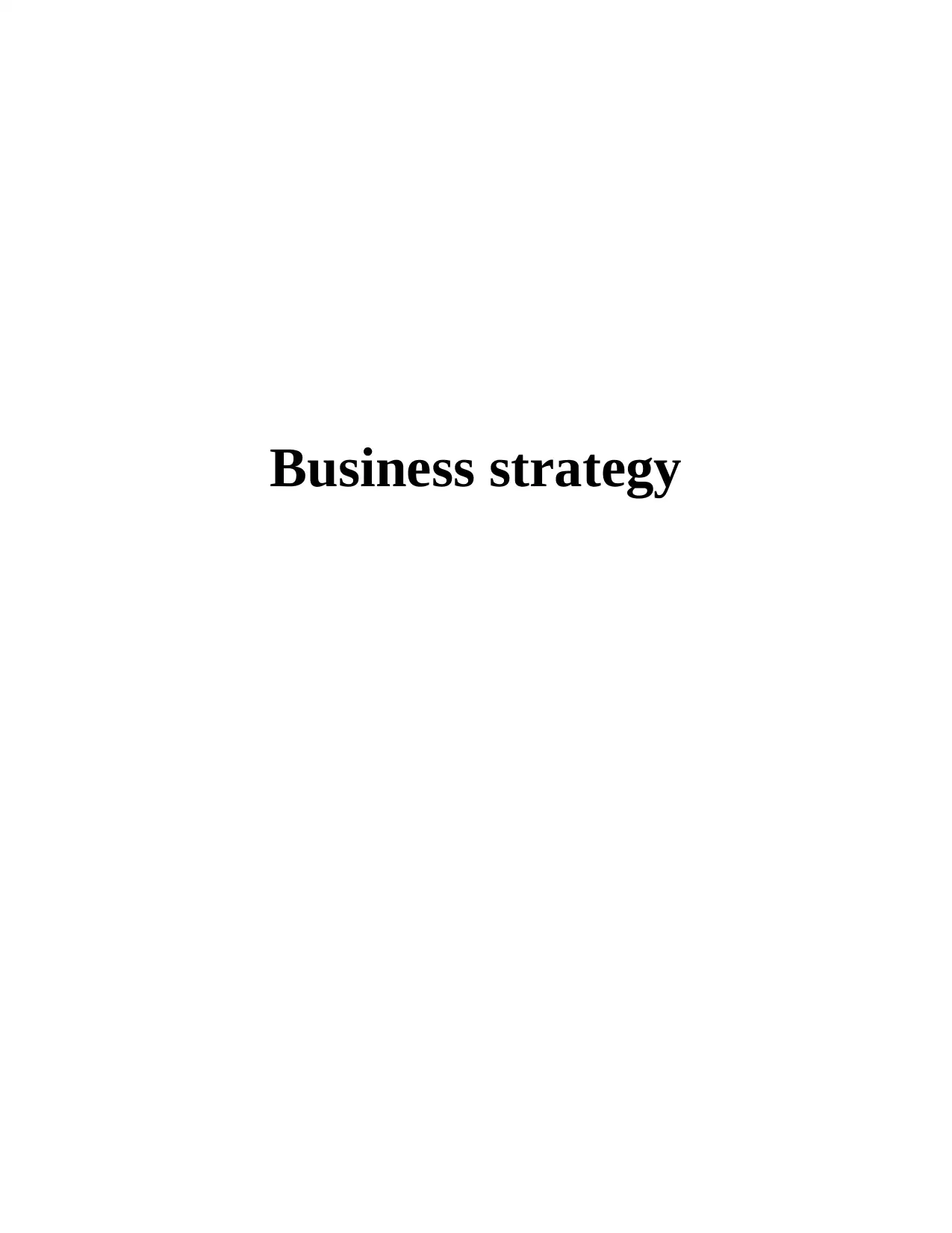
Business strategy
Paraphrase This Document
Need a fresh take? Get an instant paraphrase of this document with our AI Paraphraser
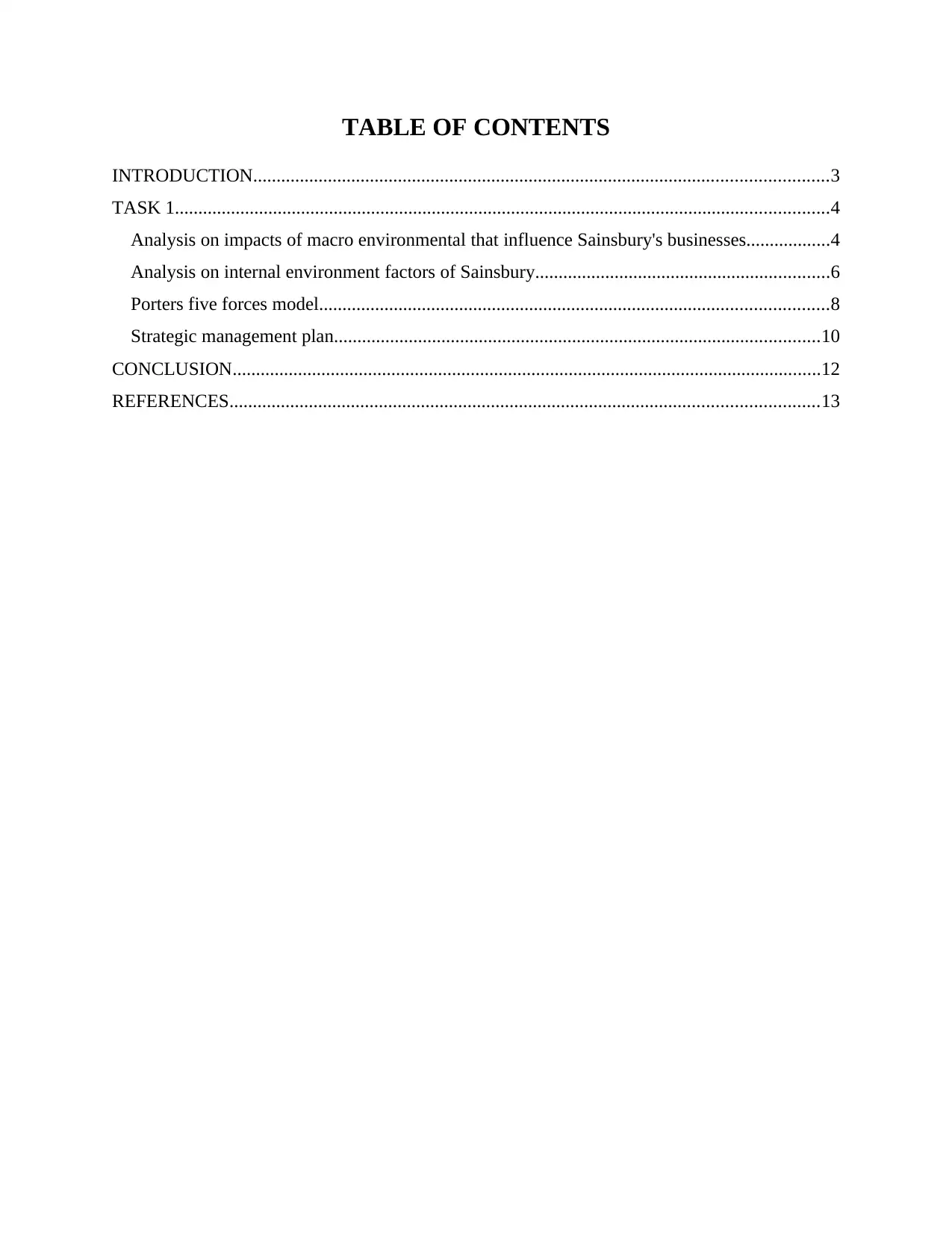
TABLE OF CONTENTS
INTRODUCTION...........................................................................................................................3
TASK 1............................................................................................................................................4
Analysis on impacts of macro environmental that influence Sainsbury's businesses..................4
Analysis on internal environment factors of Sainsbury...............................................................6
Porters five forces model.............................................................................................................8
Strategic management plan........................................................................................................10
CONCLUSION..............................................................................................................................12
REFERENCES..............................................................................................................................13
INTRODUCTION...........................................................................................................................3
TASK 1............................................................................................................................................4
Analysis on impacts of macro environmental that influence Sainsbury's businesses..................4
Analysis on internal environment factors of Sainsbury...............................................................6
Porters five forces model.............................................................................................................8
Strategic management plan........................................................................................................10
CONCLUSION..............................................................................................................................12
REFERENCES..............................................................................................................................13
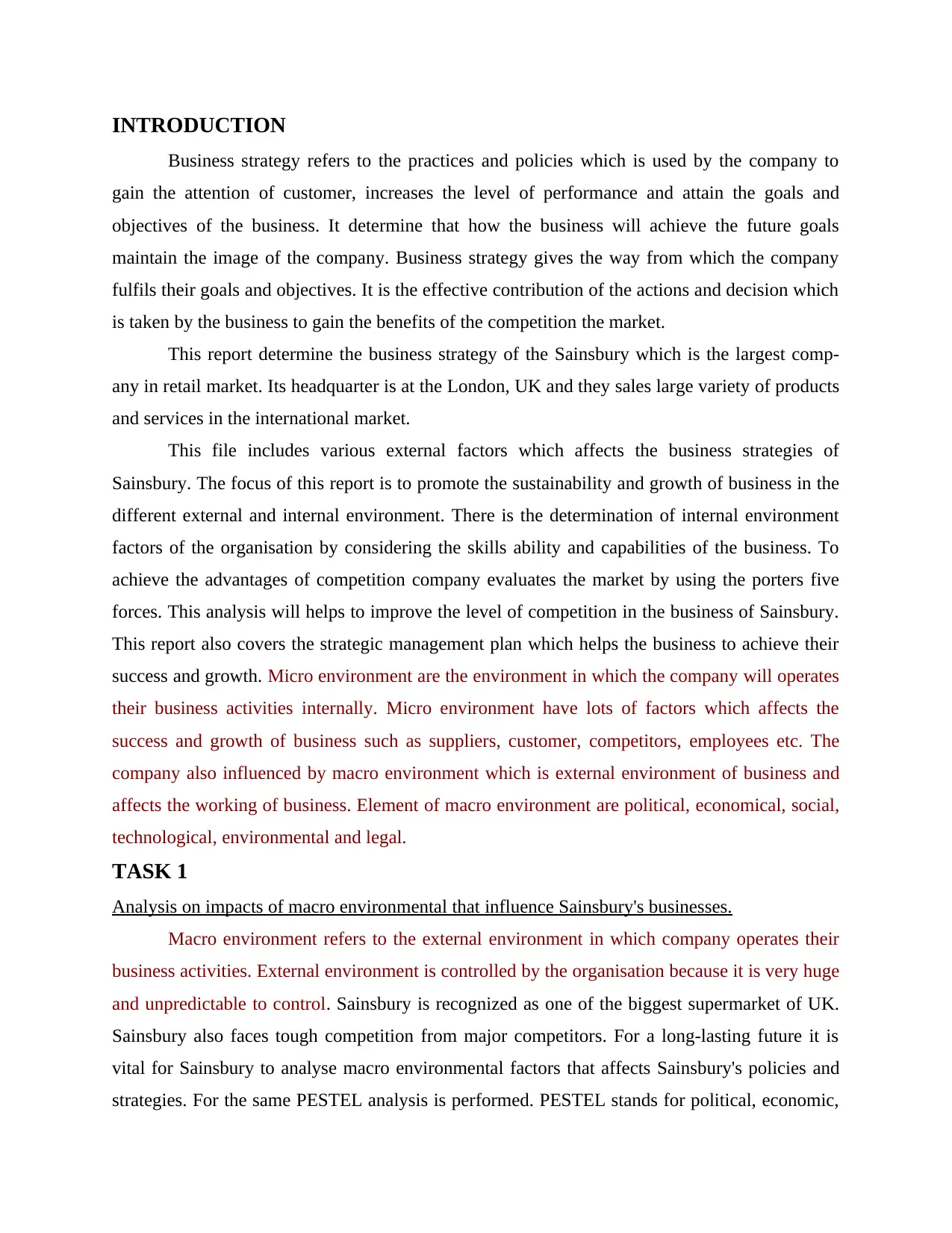
INTRODUCTION
Business strategy refers to the practices and policies which is used by the company to
gain the attention of customer, increases the level of performance and attain the goals and
objectives of the business. It determine that how the business will achieve the future goals
maintain the image of the company. Business strategy gives the way from which the company
fulfils their goals and objectives. It is the effective contribution of the actions and decision which
is taken by the business to gain the benefits of the competition the market.
This report determine the business strategy of the Sainsbury which is the largest comp-
any in retail market. Its headquarter is at the London, UK and they sales large variety of products
and services in the international market.
This file includes various external factors which affects the business strategies of
Sainsbury. The focus of this report is to promote the sustainability and growth of business in the
different external and internal environment. There is the determination of internal environment
factors of the organisation by considering the skills ability and capabilities of the business. To
achieve the advantages of competition company evaluates the market by using the porters five
forces. This analysis will helps to improve the level of competition in the business of Sainsbury.
This report also covers the strategic management plan which helps the business to achieve their
success and growth. Micro environment are the environment in which the company will operates
their business activities internally. Micro environment have lots of factors which affects the
success and growth of business such as suppliers, customer, competitors, employees etc. The
company also influenced by macro environment which is external environment of business and
affects the working of business. Element of macro environment are political, economical, social,
technological, environmental and legal.
TASK 1
Analysis on impacts of macro environmental that influence Sainsbury's businesses.
Macro environment refers to the external environment in which company operates their
business activities. External environment is controlled by the organisation because it is very huge
and unpredictable to control. Sainsbury is recognized as one of the biggest supermarket of UK.
Sainsbury also faces tough competition from major competitors. For a long-lasting future it is
vital for Sainsbury to analyse macro environmental factors that affects Sainsbury's policies and
strategies. For the same PESTEL analysis is performed. PESTEL stands for political, economic,
Business strategy refers to the practices and policies which is used by the company to
gain the attention of customer, increases the level of performance and attain the goals and
objectives of the business. It determine that how the business will achieve the future goals
maintain the image of the company. Business strategy gives the way from which the company
fulfils their goals and objectives. It is the effective contribution of the actions and decision which
is taken by the business to gain the benefits of the competition the market.
This report determine the business strategy of the Sainsbury which is the largest comp-
any in retail market. Its headquarter is at the London, UK and they sales large variety of products
and services in the international market.
This file includes various external factors which affects the business strategies of
Sainsbury. The focus of this report is to promote the sustainability and growth of business in the
different external and internal environment. There is the determination of internal environment
factors of the organisation by considering the skills ability and capabilities of the business. To
achieve the advantages of competition company evaluates the market by using the porters five
forces. This analysis will helps to improve the level of competition in the business of Sainsbury.
This report also covers the strategic management plan which helps the business to achieve their
success and growth. Micro environment are the environment in which the company will operates
their business activities internally. Micro environment have lots of factors which affects the
success and growth of business such as suppliers, customer, competitors, employees etc. The
company also influenced by macro environment which is external environment of business and
affects the working of business. Element of macro environment are political, economical, social,
technological, environmental and legal.
TASK 1
Analysis on impacts of macro environmental that influence Sainsbury's businesses.
Macro environment refers to the external environment in which company operates their
business activities. External environment is controlled by the organisation because it is very huge
and unpredictable to control. Sainsbury is recognized as one of the biggest supermarket of UK.
Sainsbury also faces tough competition from major competitors. For a long-lasting future it is
vital for Sainsbury to analyse macro environmental factors that affects Sainsbury's policies and
strategies. For the same PESTEL analysis is performed. PESTEL stands for political, economic,
⊘ This is a preview!⊘
Do you want full access?
Subscribe today to unlock all pages.

Trusted by 1+ million students worldwide
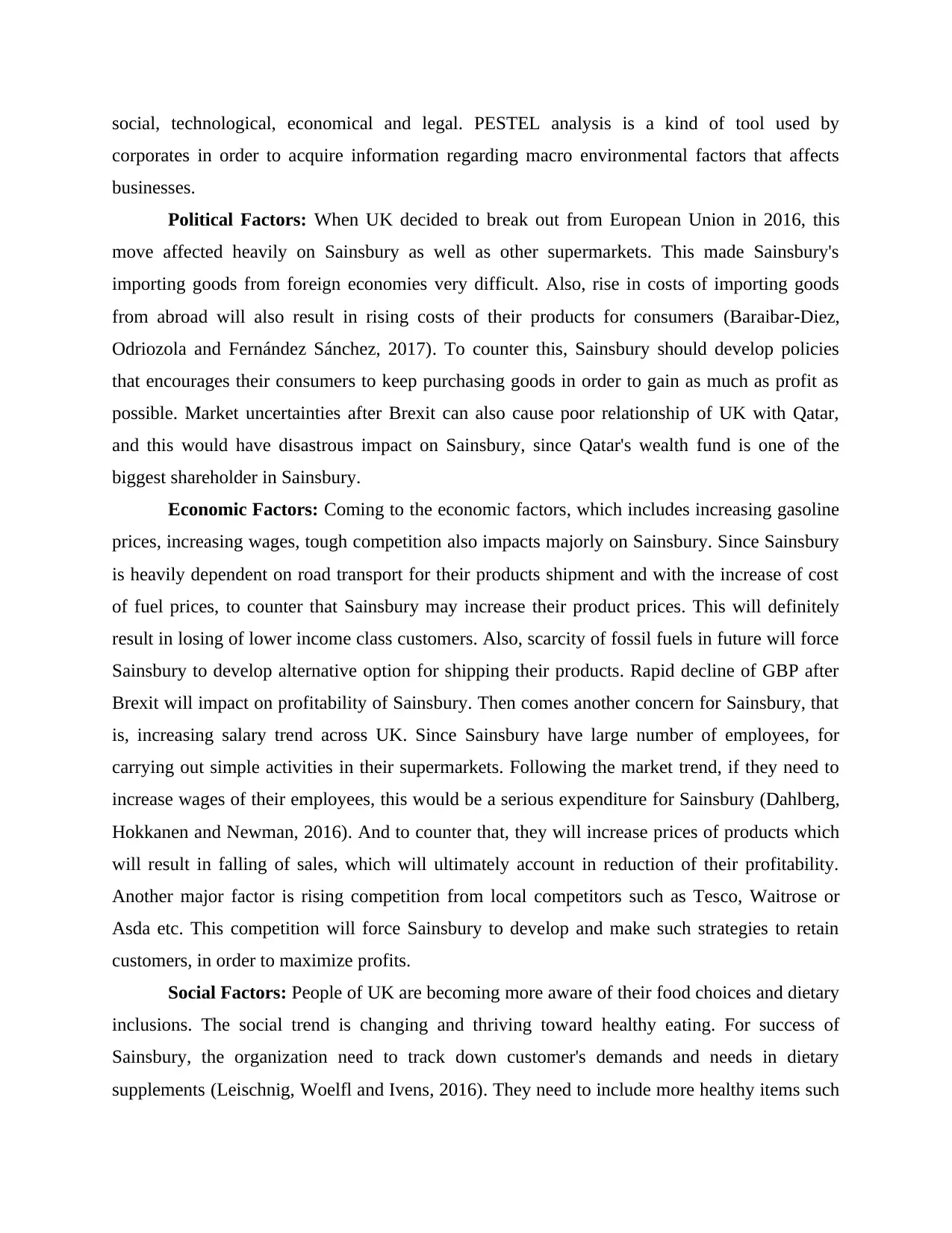
social, technological, economical and legal. PESTEL analysis is a kind of tool used by
corporates in order to acquire information regarding macro environmental factors that affects
businesses.
Political Factors: When UK decided to break out from European Union in 2016, this
move affected heavily on Sainsbury as well as other supermarkets. This made Sainsbury's
importing goods from foreign economies very difficult. Also, rise in costs of importing goods
from abroad will also result in rising costs of their products for consumers (Baraibar‐Diez,
Odriozola and Fernández Sánchez, 2017). To counter this, Sainsbury should develop policies
that encourages their consumers to keep purchasing goods in order to gain as much as profit as
possible. Market uncertainties after Brexit can also cause poor relationship of UK with Qatar,
and this would have disastrous impact on Sainsbury, since Qatar's wealth fund is one of the
biggest shareholder in Sainsbury.
Economic Factors: Coming to the economic factors, which includes increasing gasoline
prices, increasing wages, tough competition also impacts majorly on Sainsbury. Since Sainsbury
is heavily dependent on road transport for their products shipment and with the increase of cost
of fuel prices, to counter that Sainsbury may increase their product prices. This will definitely
result in losing of lower income class customers. Also, scarcity of fossil fuels in future will force
Sainsbury to develop alternative option for shipping their products. Rapid decline of GBP after
Brexit will impact on profitability of Sainsbury. Then comes another concern for Sainsbury, that
is, increasing salary trend across UK. Since Sainsbury have large number of employees, for
carrying out simple activities in their supermarkets. Following the market trend, if they need to
increase wages of their employees, this would be a serious expenditure for Sainsbury (Dahlberg,
Hokkanen and Newman, 2016). And to counter that, they will increase prices of products which
will result in falling of sales, which will ultimately account in reduction of their profitability.
Another major factor is rising competition from local competitors such as Tesco, Waitrose or
Asda etc. This competition will force Sainsbury to develop and make such strategies to retain
customers, in order to maximize profits.
Social Factors: People of UK are becoming more aware of their food choices and dietary
inclusions. The social trend is changing and thriving toward healthy eating. For success of
Sainsbury, the organization need to track down customer's demands and needs in dietary
supplements (Leischnig, Woelfl and Ivens, 2016). They need to include more healthy items such
corporates in order to acquire information regarding macro environmental factors that affects
businesses.
Political Factors: When UK decided to break out from European Union in 2016, this
move affected heavily on Sainsbury as well as other supermarkets. This made Sainsbury's
importing goods from foreign economies very difficult. Also, rise in costs of importing goods
from abroad will also result in rising costs of their products for consumers (Baraibar‐Diez,
Odriozola and Fernández Sánchez, 2017). To counter this, Sainsbury should develop policies
that encourages their consumers to keep purchasing goods in order to gain as much as profit as
possible. Market uncertainties after Brexit can also cause poor relationship of UK with Qatar,
and this would have disastrous impact on Sainsbury, since Qatar's wealth fund is one of the
biggest shareholder in Sainsbury.
Economic Factors: Coming to the economic factors, which includes increasing gasoline
prices, increasing wages, tough competition also impacts majorly on Sainsbury. Since Sainsbury
is heavily dependent on road transport for their products shipment and with the increase of cost
of fuel prices, to counter that Sainsbury may increase their product prices. This will definitely
result in losing of lower income class customers. Also, scarcity of fossil fuels in future will force
Sainsbury to develop alternative option for shipping their products. Rapid decline of GBP after
Brexit will impact on profitability of Sainsbury. Then comes another concern for Sainsbury, that
is, increasing salary trend across UK. Since Sainsbury have large number of employees, for
carrying out simple activities in their supermarkets. Following the market trend, if they need to
increase wages of their employees, this would be a serious expenditure for Sainsbury (Dahlberg,
Hokkanen and Newman, 2016). And to counter that, they will increase prices of products which
will result in falling of sales, which will ultimately account in reduction of their profitability.
Another major factor is rising competition from local competitors such as Tesco, Waitrose or
Asda etc. This competition will force Sainsbury to develop and make such strategies to retain
customers, in order to maximize profits.
Social Factors: People of UK are becoming more aware of their food choices and dietary
inclusions. The social trend is changing and thriving toward healthy eating. For success of
Sainsbury, the organization need to track down customer's demands and needs in dietary
supplements (Leischnig, Woelfl and Ivens, 2016). They need to include more healthy items such
Paraphrase This Document
Need a fresh take? Get an instant paraphrase of this document with our AI Paraphraser
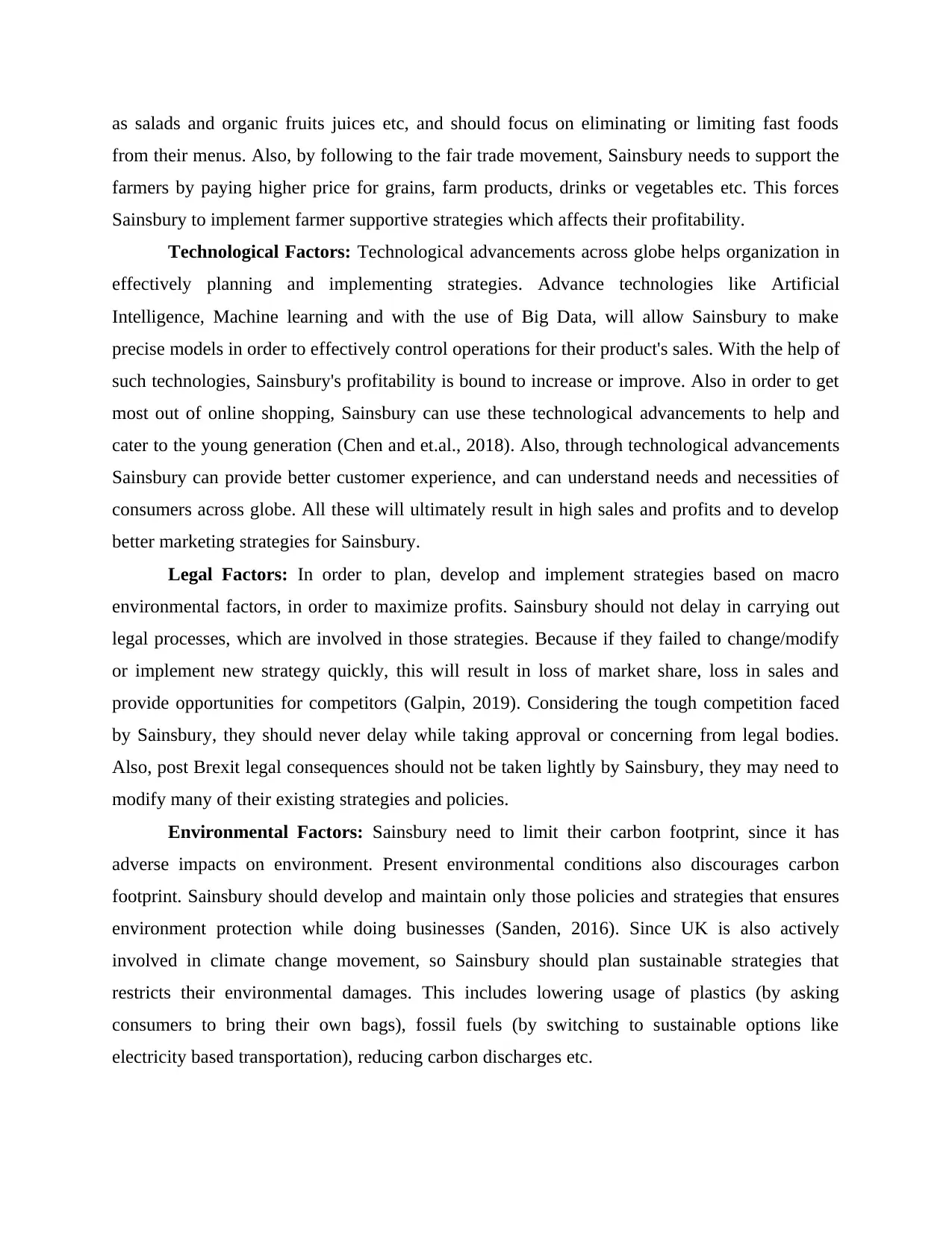
as salads and organic fruits juices etc, and should focus on eliminating or limiting fast foods
from their menus. Also, by following to the fair trade movement, Sainsbury needs to support the
farmers by paying higher price for grains, farm products, drinks or vegetables etc. This forces
Sainsbury to implement farmer supportive strategies which affects their profitability.
Technological Factors: Technological advancements across globe helps organization in
effectively planning and implementing strategies. Advance technologies like Artificial
Intelligence, Machine learning and with the use of Big Data, will allow Sainsbury to make
precise models in order to effectively control operations for their product's sales. With the help of
such technologies, Sainsbury's profitability is bound to increase or improve. Also in order to get
most out of online shopping, Sainsbury can use these technological advancements to help and
cater to the young generation (Chen and et.al., 2018). Also, through technological advancements
Sainsbury can provide better customer experience, and can understand needs and necessities of
consumers across globe. All these will ultimately result in high sales and profits and to develop
better marketing strategies for Sainsbury.
Legal Factors: In order to plan, develop and implement strategies based on macro
environmental factors, in order to maximize profits. Sainsbury should not delay in carrying out
legal processes, which are involved in those strategies. Because if they failed to change/modify
or implement new strategy quickly, this will result in loss of market share, loss in sales and
provide opportunities for competitors (Galpin, 2019). Considering the tough competition faced
by Sainsbury, they should never delay while taking approval or concerning from legal bodies.
Also, post Brexit legal consequences should not be taken lightly by Sainsbury, they may need to
modify many of their existing strategies and policies.
Environmental Factors: Sainsbury need to limit their carbon footprint, since it has
adverse impacts on environment. Present environmental conditions also discourages carbon
footprint. Sainsbury should develop and maintain only those policies and strategies that ensures
environment protection while doing businesses (Sanden, 2016). Since UK is also actively
involved in climate change movement, so Sainsbury should plan sustainable strategies that
restricts their environmental damages. This includes lowering usage of plastics (by asking
consumers to bring their own bags), fossil fuels (by switching to sustainable options like
electricity based transportation), reducing carbon discharges etc.
from their menus. Also, by following to the fair trade movement, Sainsbury needs to support the
farmers by paying higher price for grains, farm products, drinks or vegetables etc. This forces
Sainsbury to implement farmer supportive strategies which affects their profitability.
Technological Factors: Technological advancements across globe helps organization in
effectively planning and implementing strategies. Advance technologies like Artificial
Intelligence, Machine learning and with the use of Big Data, will allow Sainsbury to make
precise models in order to effectively control operations for their product's sales. With the help of
such technologies, Sainsbury's profitability is bound to increase or improve. Also in order to get
most out of online shopping, Sainsbury can use these technological advancements to help and
cater to the young generation (Chen and et.al., 2018). Also, through technological advancements
Sainsbury can provide better customer experience, and can understand needs and necessities of
consumers across globe. All these will ultimately result in high sales and profits and to develop
better marketing strategies for Sainsbury.
Legal Factors: In order to plan, develop and implement strategies based on macro
environmental factors, in order to maximize profits. Sainsbury should not delay in carrying out
legal processes, which are involved in those strategies. Because if they failed to change/modify
or implement new strategy quickly, this will result in loss of market share, loss in sales and
provide opportunities for competitors (Galpin, 2019). Considering the tough competition faced
by Sainsbury, they should never delay while taking approval or concerning from legal bodies.
Also, post Brexit legal consequences should not be taken lightly by Sainsbury, they may need to
modify many of their existing strategies and policies.
Environmental Factors: Sainsbury need to limit their carbon footprint, since it has
adverse impacts on environment. Present environmental conditions also discourages carbon
footprint. Sainsbury should develop and maintain only those policies and strategies that ensures
environment protection while doing businesses (Sanden, 2016). Since UK is also actively
involved in climate change movement, so Sainsbury should plan sustainable strategies that
restricts their environmental damages. This includes lowering usage of plastics (by asking
consumers to bring their own bags), fossil fuels (by switching to sustainable options like
electricity based transportation), reducing carbon discharges etc.
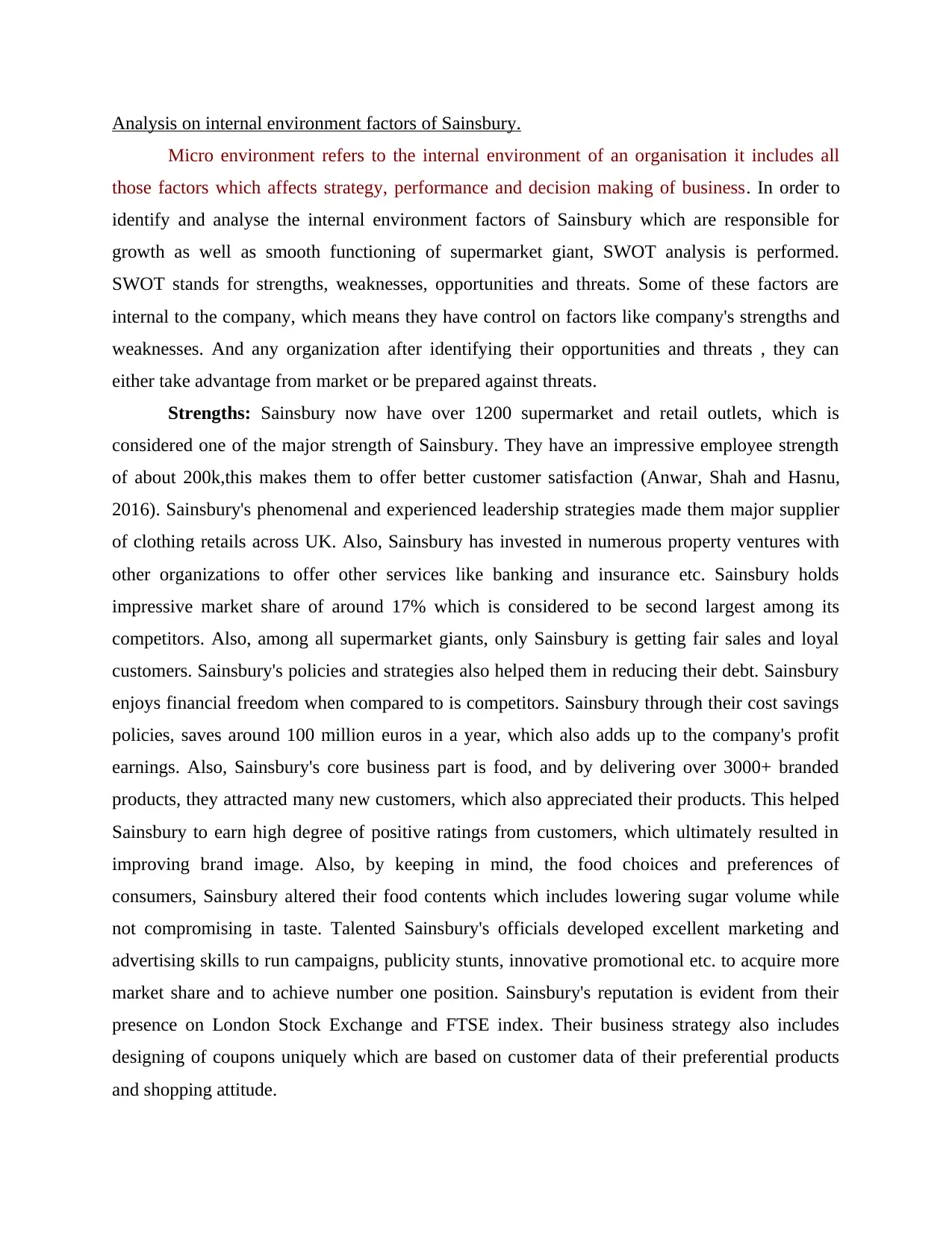
Analysis on internal environment factors of Sainsbury.
Micro environment refers to the internal environment of an organisation it includes all
those factors which affects strategy, performance and decision making of business. In order to
identify and analyse the internal environment factors of Sainsbury which are responsible for
growth as well as smooth functioning of supermarket giant, SWOT analysis is performed.
SWOT stands for strengths, weaknesses, opportunities and threats. Some of these factors are
internal to the company, which means they have control on factors like company's strengths and
weaknesses. And any organization after identifying their opportunities and threats , they can
either take advantage from market or be prepared against threats.
Strengths: Sainsbury now have over 1200 supermarket and retail outlets, which is
considered one of the major strength of Sainsbury. They have an impressive employee strength
of about 200k,this makes them to offer better customer satisfaction (Anwar, Shah and Hasnu,
2016). Sainsbury's phenomenal and experienced leadership strategies made them major supplier
of clothing retails across UK. Also, Sainsbury has invested in numerous property ventures with
other organizations to offer other services like banking and insurance etc. Sainsbury holds
impressive market share of around 17% which is considered to be second largest among its
competitors. Also, among all supermarket giants, only Sainsbury is getting fair sales and loyal
customers. Sainsbury's policies and strategies also helped them in reducing their debt. Sainsbury
enjoys financial freedom when compared to is competitors. Sainsbury through their cost savings
policies, saves around 100 million euros in a year, which also adds up to the company's profit
earnings. Also, Sainsbury's core business part is food, and by delivering over 3000+ branded
products, they attracted many new customers, which also appreciated their products. This helped
Sainsbury to earn high degree of positive ratings from customers, which ultimately resulted in
improving brand image. Also, by keeping in mind, the food choices and preferences of
consumers, Sainsbury altered their food contents which includes lowering sugar volume while
not compromising in taste. Talented Sainsbury's officials developed excellent marketing and
advertising skills to run campaigns, publicity stunts, innovative promotional etc. to acquire more
market share and to achieve number one position. Sainsbury's reputation is evident from their
presence on London Stock Exchange and FTSE index. Their business strategy also includes
designing of coupons uniquely which are based on customer data of their preferential products
and shopping attitude.
Micro environment refers to the internal environment of an organisation it includes all
those factors which affects strategy, performance and decision making of business. In order to
identify and analyse the internal environment factors of Sainsbury which are responsible for
growth as well as smooth functioning of supermarket giant, SWOT analysis is performed.
SWOT stands for strengths, weaknesses, opportunities and threats. Some of these factors are
internal to the company, which means they have control on factors like company's strengths and
weaknesses. And any organization after identifying their opportunities and threats , they can
either take advantage from market or be prepared against threats.
Strengths: Sainsbury now have over 1200 supermarket and retail outlets, which is
considered one of the major strength of Sainsbury. They have an impressive employee strength
of about 200k,this makes them to offer better customer satisfaction (Anwar, Shah and Hasnu,
2016). Sainsbury's phenomenal and experienced leadership strategies made them major supplier
of clothing retails across UK. Also, Sainsbury has invested in numerous property ventures with
other organizations to offer other services like banking and insurance etc. Sainsbury holds
impressive market share of around 17% which is considered to be second largest among its
competitors. Also, among all supermarket giants, only Sainsbury is getting fair sales and loyal
customers. Sainsbury's policies and strategies also helped them in reducing their debt. Sainsbury
enjoys financial freedom when compared to is competitors. Sainsbury through their cost savings
policies, saves around 100 million euros in a year, which also adds up to the company's profit
earnings. Also, Sainsbury's core business part is food, and by delivering over 3000+ branded
products, they attracted many new customers, which also appreciated their products. This helped
Sainsbury to earn high degree of positive ratings from customers, which ultimately resulted in
improving brand image. Also, by keeping in mind, the food choices and preferences of
consumers, Sainsbury altered their food contents which includes lowering sugar volume while
not compromising in taste. Talented Sainsbury's officials developed excellent marketing and
advertising skills to run campaigns, publicity stunts, innovative promotional etc. to acquire more
market share and to achieve number one position. Sainsbury's reputation is evident from their
presence on London Stock Exchange and FTSE index. Their business strategy also includes
designing of coupons uniquely which are based on customer data of their preferential products
and shopping attitude.
⊘ This is a preview!⊘
Do you want full access?
Subscribe today to unlock all pages.

Trusted by 1+ million students worldwide
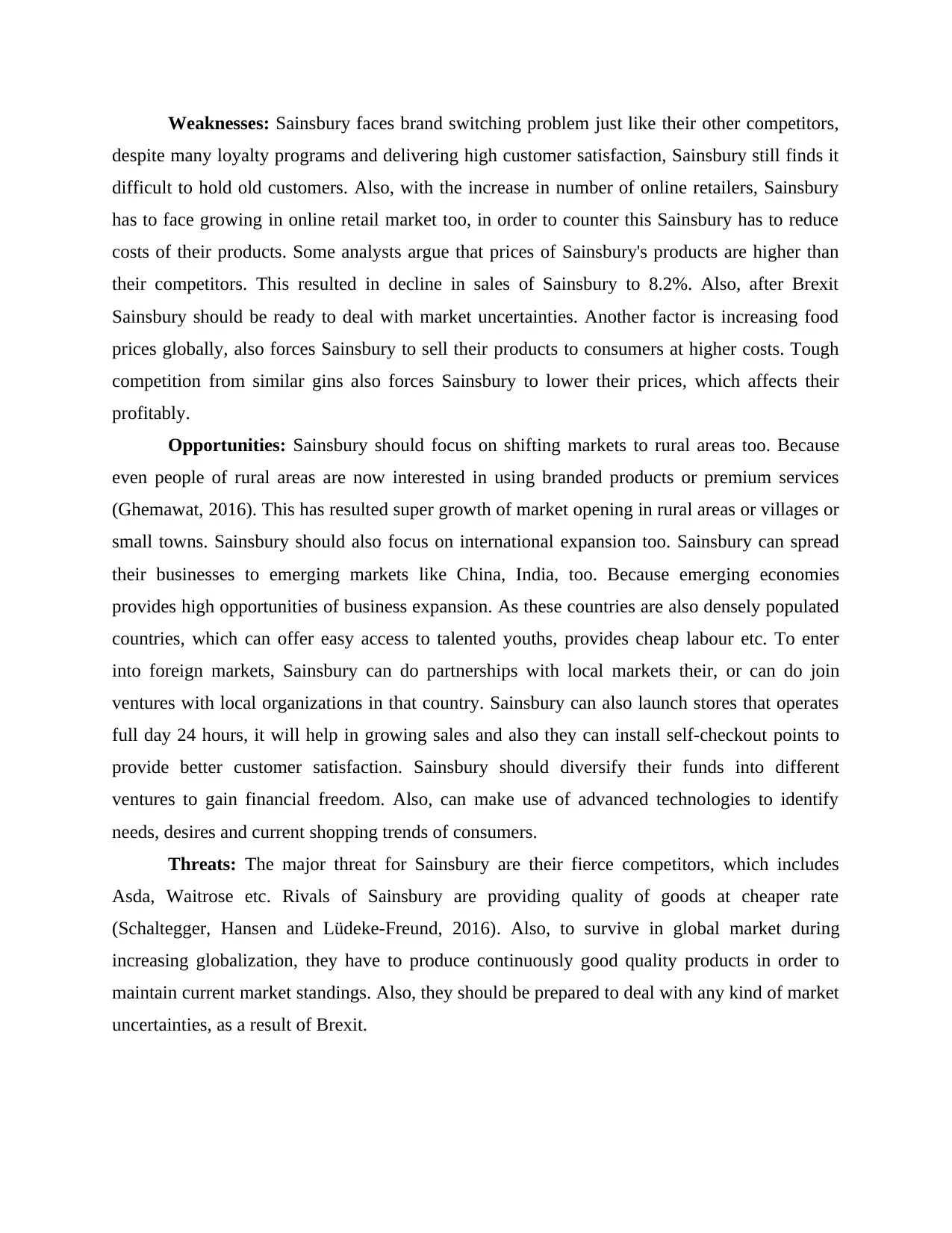
Weaknesses: Sainsbury faces brand switching problem just like their other competitors,
despite many loyalty programs and delivering high customer satisfaction, Sainsbury still finds it
difficult to hold old customers. Also, with the increase in number of online retailers, Sainsbury
has to face growing in online retail market too, in order to counter this Sainsbury has to reduce
costs of their products. Some analysts argue that prices of Sainsbury's products are higher than
their competitors. This resulted in decline in sales of Sainsbury to 8.2%. Also, after Brexit
Sainsbury should be ready to deal with market uncertainties. Another factor is increasing food
prices globally, also forces Sainsbury to sell their products to consumers at higher costs. Tough
competition from similar gins also forces Sainsbury to lower their prices, which affects their
profitably.
Opportunities: Sainsbury should focus on shifting markets to rural areas too. Because
even people of rural areas are now interested in using branded products or premium services
(Ghemawat, 2016). This has resulted super growth of market opening in rural areas or villages or
small towns. Sainsbury should also focus on international expansion too. Sainsbury can spread
their businesses to emerging markets like China, India, too. Because emerging economies
provides high opportunities of business expansion. As these countries are also densely populated
countries, which can offer easy access to talented youths, provides cheap labour etc. To enter
into foreign markets, Sainsbury can do partnerships with local markets their, or can do join
ventures with local organizations in that country. Sainsbury can also launch stores that operates
full day 24 hours, it will help in growing sales and also they can install self-checkout points to
provide better customer satisfaction. Sainsbury should diversify their funds into different
ventures to gain financial freedom. Also, can make use of advanced technologies to identify
needs, desires and current shopping trends of consumers.
Threats: The major threat for Sainsbury are their fierce competitors, which includes
Asda, Waitrose etc. Rivals of Sainsbury are providing quality of goods at cheaper rate
(Schaltegger, Hansen and Lüdeke-Freund, 2016). Also, to survive in global market during
increasing globalization, they have to produce continuously good quality products in order to
maintain current market standings. Also, they should be prepared to deal with any kind of market
uncertainties, as a result of Brexit.
despite many loyalty programs and delivering high customer satisfaction, Sainsbury still finds it
difficult to hold old customers. Also, with the increase in number of online retailers, Sainsbury
has to face growing in online retail market too, in order to counter this Sainsbury has to reduce
costs of their products. Some analysts argue that prices of Sainsbury's products are higher than
their competitors. This resulted in decline in sales of Sainsbury to 8.2%. Also, after Brexit
Sainsbury should be ready to deal with market uncertainties. Another factor is increasing food
prices globally, also forces Sainsbury to sell their products to consumers at higher costs. Tough
competition from similar gins also forces Sainsbury to lower their prices, which affects their
profitably.
Opportunities: Sainsbury should focus on shifting markets to rural areas too. Because
even people of rural areas are now interested in using branded products or premium services
(Ghemawat, 2016). This has resulted super growth of market opening in rural areas or villages or
small towns. Sainsbury should also focus on international expansion too. Sainsbury can spread
their businesses to emerging markets like China, India, too. Because emerging economies
provides high opportunities of business expansion. As these countries are also densely populated
countries, which can offer easy access to talented youths, provides cheap labour etc. To enter
into foreign markets, Sainsbury can do partnerships with local markets their, or can do join
ventures with local organizations in that country. Sainsbury can also launch stores that operates
full day 24 hours, it will help in growing sales and also they can install self-checkout points to
provide better customer satisfaction. Sainsbury should diversify their funds into different
ventures to gain financial freedom. Also, can make use of advanced technologies to identify
needs, desires and current shopping trends of consumers.
Threats: The major threat for Sainsbury are their fierce competitors, which includes
Asda, Waitrose etc. Rivals of Sainsbury are providing quality of goods at cheaper rate
(Schaltegger, Hansen and Lüdeke-Freund, 2016). Also, to survive in global market during
increasing globalization, they have to produce continuously good quality products in order to
maintain current market standings. Also, they should be prepared to deal with any kind of market
uncertainties, as a result of Brexit.
Paraphrase This Document
Need a fresh take? Get an instant paraphrase of this document with our AI Paraphraser
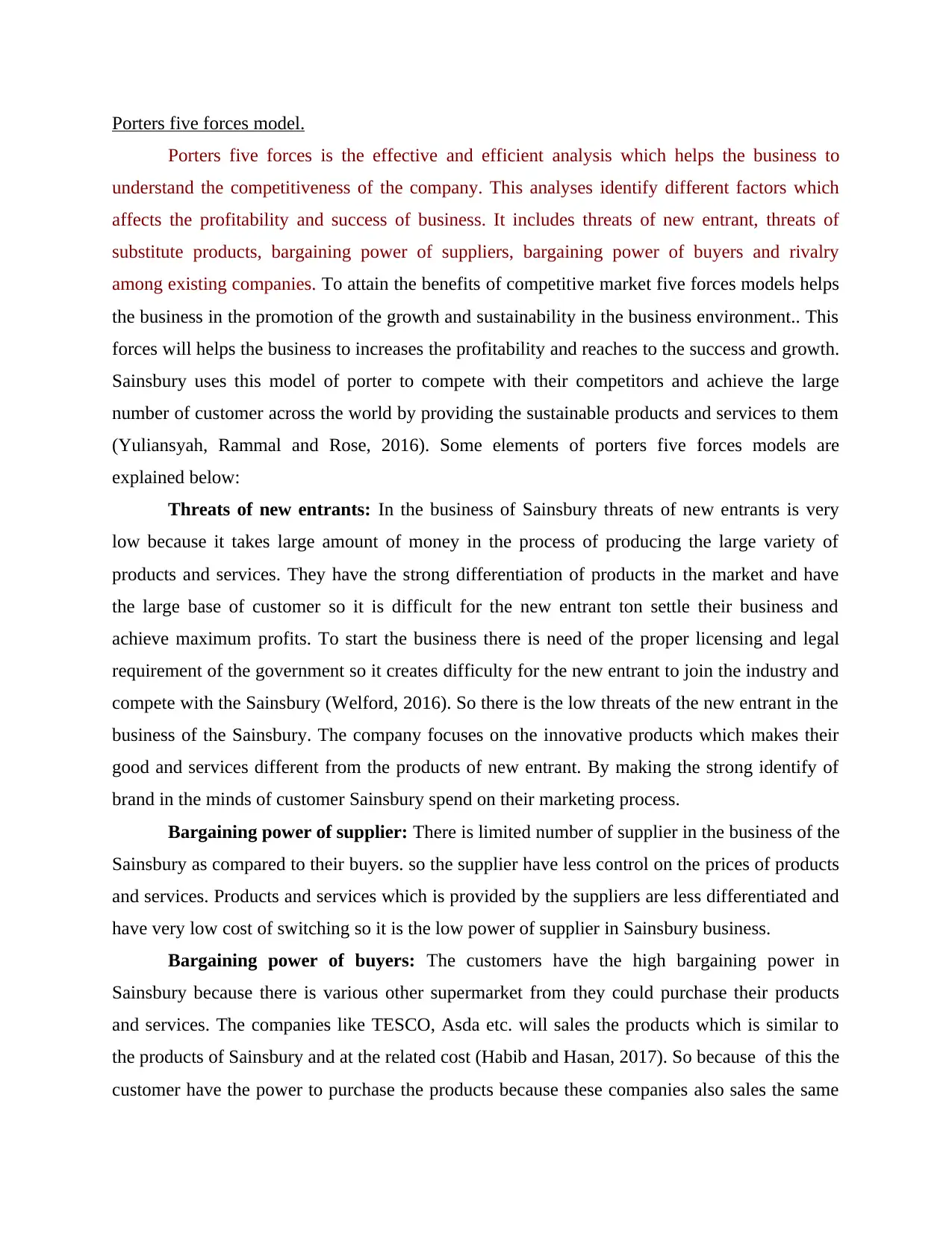
Porters five forces model.
Porters five forces is the effective and efficient analysis which helps the business to
understand the competitiveness of the company. This analyses identify different factors which
affects the profitability and success of business. It includes threats of new entrant, threats of
substitute products, bargaining power of suppliers, bargaining power of buyers and rivalry
among existing companies. To attain the benefits of competitive market five forces models helps
the business in the promotion of the growth and sustainability in the business environment.. This
forces will helps the business to increases the profitability and reaches to the success and growth.
Sainsbury uses this model of porter to compete with their competitors and achieve the large
number of customer across the world by providing the sustainable products and services to them
(Yuliansyah, Rammal and Rose, 2016). Some elements of porters five forces models are
explained below:
Threats of new entrants: In the business of Sainsbury threats of new entrants is very
low because it takes large amount of money in the process of producing the large variety of
products and services. They have the strong differentiation of products in the market and have
the large base of customer so it is difficult for the new entrant ton settle their business and
achieve maximum profits. To start the business there is need of the proper licensing and legal
requirement of the government so it creates difficulty for the new entrant to join the industry and
compete with the Sainsbury (Welford, 2016). So there is the low threats of the new entrant in the
business of the Sainsbury. The company focuses on the innovative products which makes their
good and services different from the products of new entrant. By making the strong identify of
brand in the minds of customer Sainsbury spend on their marketing process.
Bargaining power of supplier: There is limited number of supplier in the business of the
Sainsbury as compared to their buyers. so the supplier have less control on the prices of products
and services. Products and services which is provided by the suppliers are less differentiated and
have very low cost of switching so it is the low power of supplier in Sainsbury business.
Bargaining power of buyers: The customers have the high bargaining power in
Sainsbury because there is various other supermarket from they could purchase their products
and services. The companies like TESCO, Asda etc. will sales the products which is similar to
the products of Sainsbury and at the related cost (Habib and Hasan, 2017). So because of this the
customer have the power to purchase the products because these companies also sales the same
Porters five forces is the effective and efficient analysis which helps the business to
understand the competitiveness of the company. This analyses identify different factors which
affects the profitability and success of business. It includes threats of new entrant, threats of
substitute products, bargaining power of suppliers, bargaining power of buyers and rivalry
among existing companies. To attain the benefits of competitive market five forces models helps
the business in the promotion of the growth and sustainability in the business environment.. This
forces will helps the business to increases the profitability and reaches to the success and growth.
Sainsbury uses this model of porter to compete with their competitors and achieve the large
number of customer across the world by providing the sustainable products and services to them
(Yuliansyah, Rammal and Rose, 2016). Some elements of porters five forces models are
explained below:
Threats of new entrants: In the business of Sainsbury threats of new entrants is very
low because it takes large amount of money in the process of producing the large variety of
products and services. They have the strong differentiation of products in the market and have
the large base of customer so it is difficult for the new entrant ton settle their business and
achieve maximum profits. To start the business there is need of the proper licensing and legal
requirement of the government so it creates difficulty for the new entrant to join the industry and
compete with the Sainsbury (Welford, 2016). So there is the low threats of the new entrant in the
business of the Sainsbury. The company focuses on the innovative products which makes their
good and services different from the products of new entrant. By making the strong identify of
brand in the minds of customer Sainsbury spend on their marketing process.
Bargaining power of supplier: There is limited number of supplier in the business of the
Sainsbury as compared to their buyers. so the supplier have less control on the prices of products
and services. Products and services which is provided by the suppliers are less differentiated and
have very low cost of switching so it is the low power of supplier in Sainsbury business.
Bargaining power of buyers: The customers have the high bargaining power in
Sainsbury because there is various other supermarket from they could purchase their products
and services. The companies like TESCO, Asda etc. will sales the products which is similar to
the products of Sainsbury and at the related cost (Habib and Hasan, 2017). So because of this the
customer have the power to purchase the products because these companies also sales the same
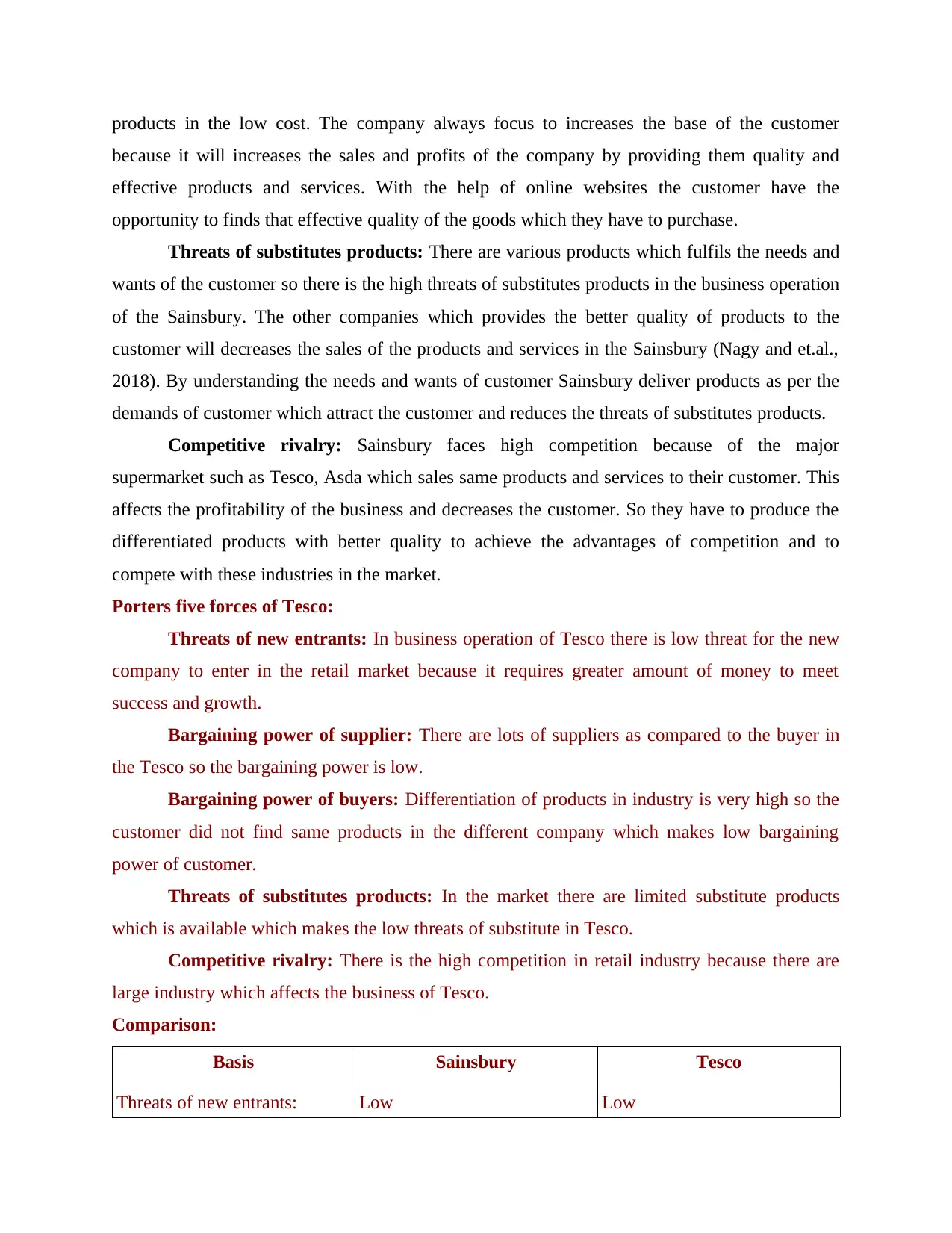
products in the low cost. The company always focus to increases the base of the customer
because it will increases the sales and profits of the company by providing them quality and
effective products and services. With the help of online websites the customer have the
opportunity to finds that effective quality of the goods which they have to purchase.
Threats of substitutes products: There are various products which fulfils the needs and
wants of the customer so there is the high threats of substitutes products in the business operation
of the Sainsbury. The other companies which provides the better quality of products to the
customer will decreases the sales of the products and services in the Sainsbury (Nagy and et.al.,
2018). By understanding the needs and wants of customer Sainsbury deliver products as per the
demands of customer which attract the customer and reduces the threats of substitutes products.
Competitive rivalry: Sainsbury faces high competition because of the major
supermarket such as Tesco, Asda which sales same products and services to their customer. This
affects the profitability of the business and decreases the customer. So they have to produce the
differentiated products with better quality to achieve the advantages of competition and to
compete with these industries in the market.
Porters five forces of Tesco:
Threats of new entrants: In business operation of Tesco there is low threat for the new
company to enter in the retail market because it requires greater amount of money to meet
success and growth.
Bargaining power of supplier: There are lots of suppliers as compared to the buyer in
the Tesco so the bargaining power is low.
Bargaining power of buyers: Differentiation of products in industry is very high so the
customer did not find same products in the different company which makes low bargaining
power of customer.
Threats of substitutes products: In the market there are limited substitute products
which is available which makes the low threats of substitute in Tesco.
Competitive rivalry: There is the high competition in retail industry because there are
large industry which affects the business of Tesco.
Comparison:
Basis Sainsbury Tesco
Threats of new entrants: Low Low
because it will increases the sales and profits of the company by providing them quality and
effective products and services. With the help of online websites the customer have the
opportunity to finds that effective quality of the goods which they have to purchase.
Threats of substitutes products: There are various products which fulfils the needs and
wants of the customer so there is the high threats of substitutes products in the business operation
of the Sainsbury. The other companies which provides the better quality of products to the
customer will decreases the sales of the products and services in the Sainsbury (Nagy and et.al.,
2018). By understanding the needs and wants of customer Sainsbury deliver products as per the
demands of customer which attract the customer and reduces the threats of substitutes products.
Competitive rivalry: Sainsbury faces high competition because of the major
supermarket such as Tesco, Asda which sales same products and services to their customer. This
affects the profitability of the business and decreases the customer. So they have to produce the
differentiated products with better quality to achieve the advantages of competition and to
compete with these industries in the market.
Porters five forces of Tesco:
Threats of new entrants: In business operation of Tesco there is low threat for the new
company to enter in the retail market because it requires greater amount of money to meet
success and growth.
Bargaining power of supplier: There are lots of suppliers as compared to the buyer in
the Tesco so the bargaining power is low.
Bargaining power of buyers: Differentiation of products in industry is very high so the
customer did not find same products in the different company which makes low bargaining
power of customer.
Threats of substitutes products: In the market there are limited substitute products
which is available which makes the low threats of substitute in Tesco.
Competitive rivalry: There is the high competition in retail industry because there are
large industry which affects the business of Tesco.
Comparison:
Basis Sainsbury Tesco
Threats of new entrants: Low Low
⊘ This is a preview!⊘
Do you want full access?
Subscribe today to unlock all pages.

Trusted by 1+ million students worldwide
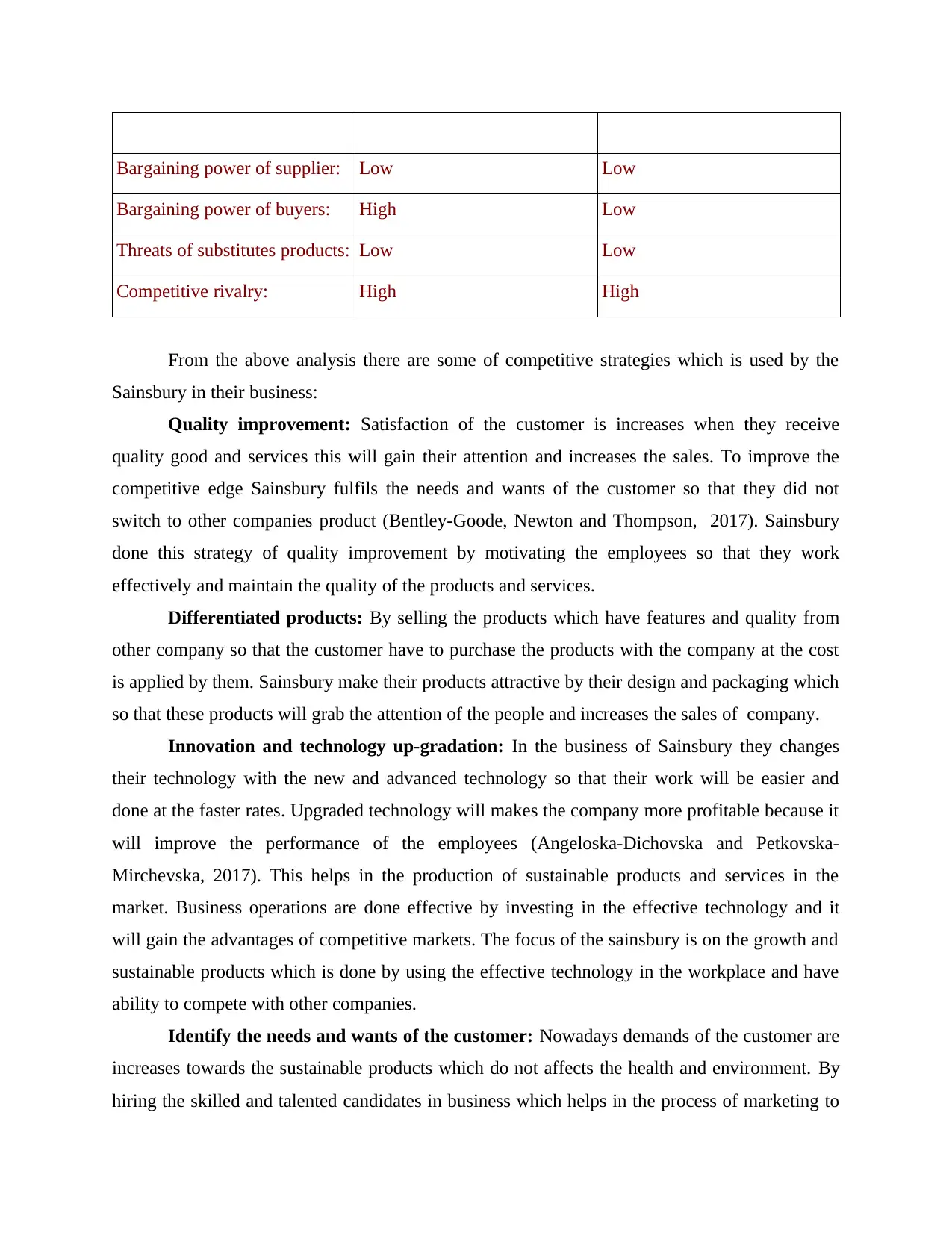
Bargaining power of supplier: Low Low
Bargaining power of buyers: High Low
Threats of substitutes products: Low Low
Competitive rivalry: High High
From the above analysis there are some of competitive strategies which is used by the
Sainsbury in their business:
Quality improvement: Satisfaction of the customer is increases when they receive
quality good and services this will gain their attention and increases the sales. To improve the
competitive edge Sainsbury fulfils the needs and wants of the customer so that they did not
switch to other companies product (Bentley-Goode, Newton and Thompson, 2017). Sainsbury
done this strategy of quality improvement by motivating the employees so that they work
effectively and maintain the quality of the products and services.
Differentiated products: By selling the products which have features and quality from
other company so that the customer have to purchase the products with the company at the cost
is applied by them. Sainsbury make their products attractive by their design and packaging which
so that these products will grab the attention of the people and increases the sales of company.
Innovation and technology up-gradation: In the business of Sainsbury they changes
their technology with the new and advanced technology so that their work will be easier and
done at the faster rates. Upgraded technology will makes the company more profitable because it
will improve the performance of the employees (Angeloska-Dichovska and Petkovska-
Mirchevska, 2017). This helps in the production of sustainable products and services in the
market. Business operations are done effective by investing in the effective technology and it
will gain the advantages of competitive markets. The focus of the sainsbury is on the growth and
sustainable products which is done by using the effective technology in the workplace and have
ability to compete with other companies.
Identify the needs and wants of the customer: Nowadays demands of the customer are
increases towards the sustainable products which do not affects the health and environment. By
hiring the skilled and talented candidates in business which helps in the process of marketing to
Bargaining power of buyers: High Low
Threats of substitutes products: Low Low
Competitive rivalry: High High
From the above analysis there are some of competitive strategies which is used by the
Sainsbury in their business:
Quality improvement: Satisfaction of the customer is increases when they receive
quality good and services this will gain their attention and increases the sales. To improve the
competitive edge Sainsbury fulfils the needs and wants of the customer so that they did not
switch to other companies product (Bentley-Goode, Newton and Thompson, 2017). Sainsbury
done this strategy of quality improvement by motivating the employees so that they work
effectively and maintain the quality of the products and services.
Differentiated products: By selling the products which have features and quality from
other company so that the customer have to purchase the products with the company at the cost
is applied by them. Sainsbury make their products attractive by their design and packaging which
so that these products will grab the attention of the people and increases the sales of company.
Innovation and technology up-gradation: In the business of Sainsbury they changes
their technology with the new and advanced technology so that their work will be easier and
done at the faster rates. Upgraded technology will makes the company more profitable because it
will improve the performance of the employees (Angeloska-Dichovska and Petkovska-
Mirchevska, 2017). This helps in the production of sustainable products and services in the
market. Business operations are done effective by investing in the effective technology and it
will gain the advantages of competitive markets. The focus of the sainsbury is on the growth and
sustainable products which is done by using the effective technology in the workplace and have
ability to compete with other companies.
Identify the needs and wants of the customer: Nowadays demands of the customer are
increases towards the sustainable products which do not affects the health and environment. By
hiring the skilled and talented candidates in business which helps in the process of marketing to
Paraphrase This Document
Need a fresh take? Get an instant paraphrase of this document with our AI Paraphraser
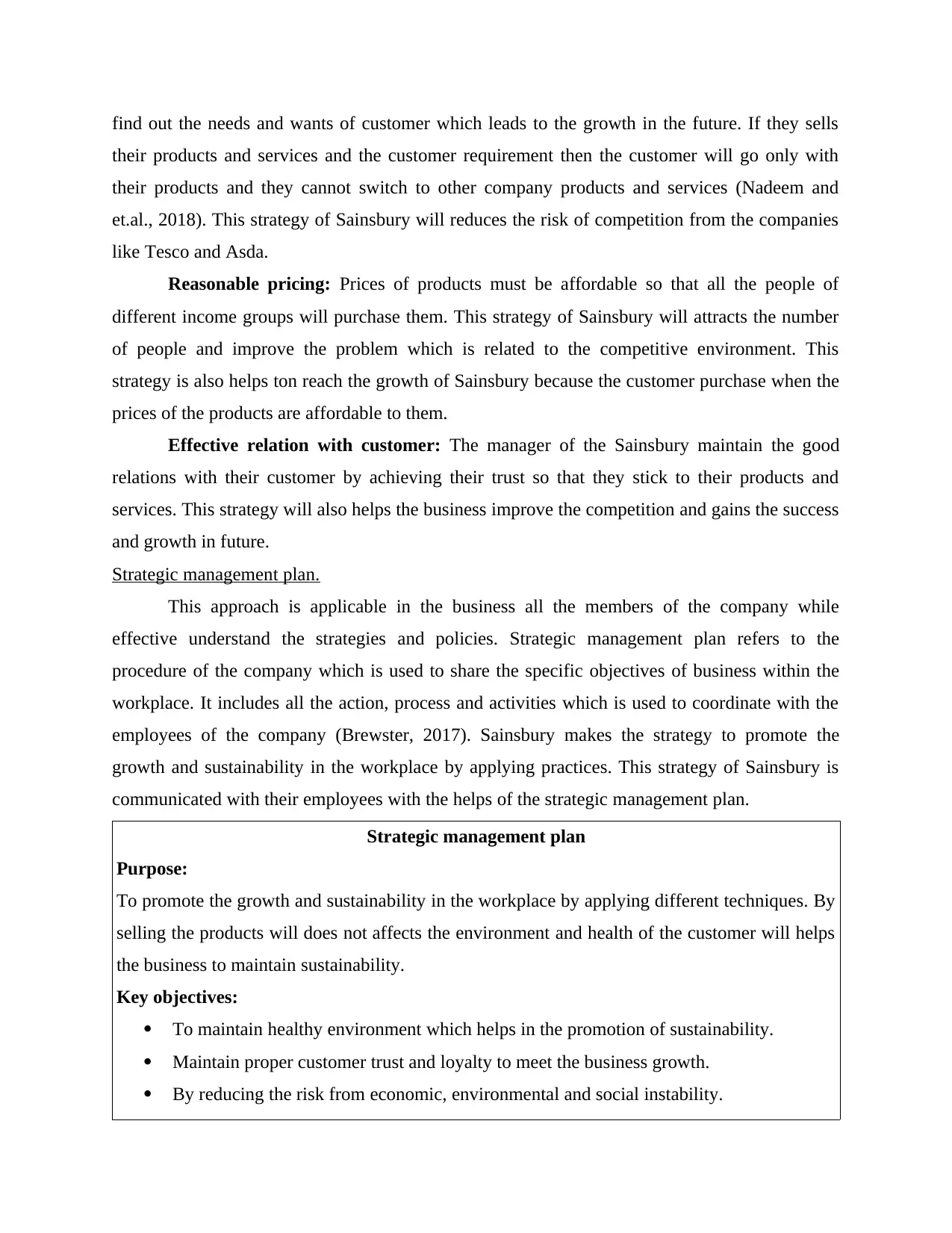
find out the needs and wants of customer which leads to the growth in the future. If they sells
their products and services and the customer requirement then the customer will go only with
their products and they cannot switch to other company products and services (Nadeem and
et.al., 2018). This strategy of Sainsbury will reduces the risk of competition from the companies
like Tesco and Asda.
Reasonable pricing: Prices of products must be affordable so that all the people of
different income groups will purchase them. This strategy of Sainsbury will attracts the number
of people and improve the problem which is related to the competitive environment. This
strategy is also helps ton reach the growth of Sainsbury because the customer purchase when the
prices of the products are affordable to them.
Effective relation with customer: The manager of the Sainsbury maintain the good
relations with their customer by achieving their trust so that they stick to their products and
services. This strategy will also helps the business improve the competition and gains the success
and growth in future.
Strategic management plan.
This approach is applicable in the business all the members of the company while
effective understand the strategies and policies. Strategic management plan refers to the
procedure of the company which is used to share the specific objectives of business within the
workplace. It includes all the action, process and activities which is used to coordinate with the
employees of the company (Brewster, 2017). Sainsbury makes the strategy to promote the
growth and sustainability in the workplace by applying practices. This strategy of Sainsbury is
communicated with their employees with the helps of the strategic management plan.
Strategic management plan
Purpose:
To promote the growth and sustainability in the workplace by applying different techniques. By
selling the products will does not affects the environment and health of the customer will helps
the business to maintain sustainability.
Key objectives:
To maintain healthy environment which helps in the promotion of sustainability.
Maintain proper customer trust and loyalty to meet the business growth.
By reducing the risk from economic, environmental and social instability.
their products and services and the customer requirement then the customer will go only with
their products and they cannot switch to other company products and services (Nadeem and
et.al., 2018). This strategy of Sainsbury will reduces the risk of competition from the companies
like Tesco and Asda.
Reasonable pricing: Prices of products must be affordable so that all the people of
different income groups will purchase them. This strategy of Sainsbury will attracts the number
of people and improve the problem which is related to the competitive environment. This
strategy is also helps ton reach the growth of Sainsbury because the customer purchase when the
prices of the products are affordable to them.
Effective relation with customer: The manager of the Sainsbury maintain the good
relations with their customer by achieving their trust so that they stick to their products and
services. This strategy will also helps the business improve the competition and gains the success
and growth in future.
Strategic management plan.
This approach is applicable in the business all the members of the company while
effective understand the strategies and policies. Strategic management plan refers to the
procedure of the company which is used to share the specific objectives of business within the
workplace. It includes all the action, process and activities which is used to coordinate with the
employees of the company (Brewster, 2017). Sainsbury makes the strategy to promote the
growth and sustainability in the workplace by applying practices. This strategy of Sainsbury is
communicated with their employees with the helps of the strategic management plan.
Strategic management plan
Purpose:
To promote the growth and sustainability in the workplace by applying different techniques. By
selling the products will does not affects the environment and health of the customer will helps
the business to maintain sustainability.
Key objectives:
To maintain healthy environment which helps in the promotion of sustainability.
Maintain proper customer trust and loyalty to meet the business growth.
By reducing the risk from economic, environmental and social instability.
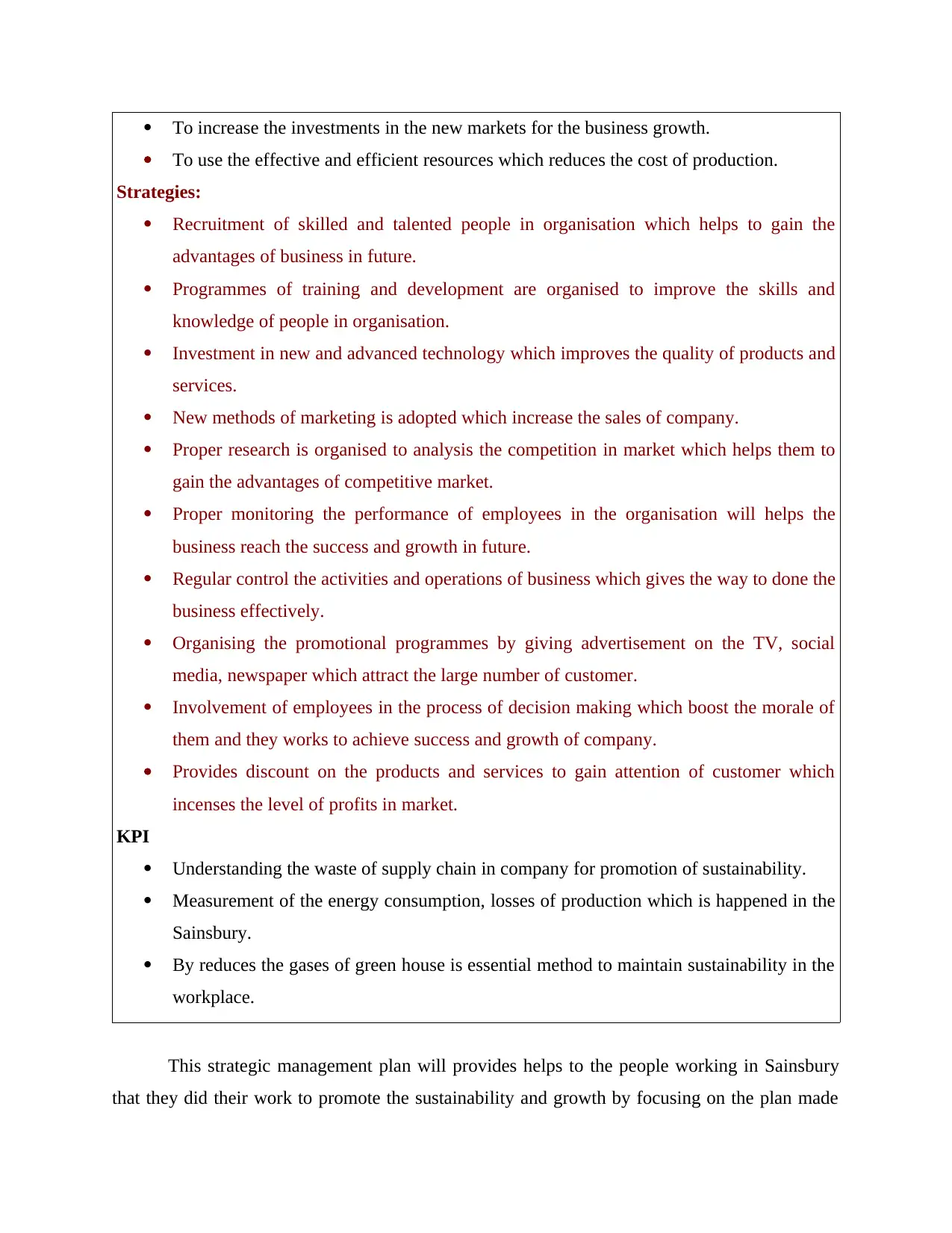
To increase the investments in the new markets for the business growth.
To use the effective and efficient resources which reduces the cost of production.
Strategies:
Recruitment of skilled and talented people in organisation which helps to gain the
advantages of business in future.
Programmes of training and development are organised to improve the skills and
knowledge of people in organisation.
Investment in new and advanced technology which improves the quality of products and
services.
New methods of marketing is adopted which increase the sales of company.
Proper research is organised to analysis the competition in market which helps them to
gain the advantages of competitive market.
Proper monitoring the performance of employees in the organisation will helps the
business reach the success and growth in future.
Regular control the activities and operations of business which gives the way to done the
business effectively.
Organising the promotional programmes by giving advertisement on the TV, social
media, newspaper which attract the large number of customer.
Involvement of employees in the process of decision making which boost the morale of
them and they works to achieve success and growth of company.
Provides discount on the products and services to gain attention of customer which
incenses the level of profits in market.
KPI
Understanding the waste of supply chain in company for promotion of sustainability.
Measurement of the energy consumption, losses of production which is happened in the
Sainsbury.
By reduces the gases of green house is essential method to maintain sustainability in the
workplace.
This strategic management plan will provides helps to the people working in Sainsbury
that they did their work to promote the sustainability and growth by focusing on the plan made
To use the effective and efficient resources which reduces the cost of production.
Strategies:
Recruitment of skilled and talented people in organisation which helps to gain the
advantages of business in future.
Programmes of training and development are organised to improve the skills and
knowledge of people in organisation.
Investment in new and advanced technology which improves the quality of products and
services.
New methods of marketing is adopted which increase the sales of company.
Proper research is organised to analysis the competition in market which helps them to
gain the advantages of competitive market.
Proper monitoring the performance of employees in the organisation will helps the
business reach the success and growth in future.
Regular control the activities and operations of business which gives the way to done the
business effectively.
Organising the promotional programmes by giving advertisement on the TV, social
media, newspaper which attract the large number of customer.
Involvement of employees in the process of decision making which boost the morale of
them and they works to achieve success and growth of company.
Provides discount on the products and services to gain attention of customer which
incenses the level of profits in market.
KPI
Understanding the waste of supply chain in company for promotion of sustainability.
Measurement of the energy consumption, losses of production which is happened in the
Sainsbury.
By reduces the gases of green house is essential method to maintain sustainability in the
workplace.
This strategic management plan will provides helps to the people working in Sainsbury
that they did their work to promote the sustainability and growth by focusing on the plan made
⊘ This is a preview!⊘
Do you want full access?
Subscribe today to unlock all pages.

Trusted by 1+ million students worldwide
1 out of 16
Related Documents
Your All-in-One AI-Powered Toolkit for Academic Success.
+13062052269
info@desklib.com
Available 24*7 on WhatsApp / Email
![[object Object]](/_next/static/media/star-bottom.7253800d.svg)
Unlock your academic potential
Copyright © 2020–2025 A2Z Services. All Rights Reserved. Developed and managed by ZUCOL.





